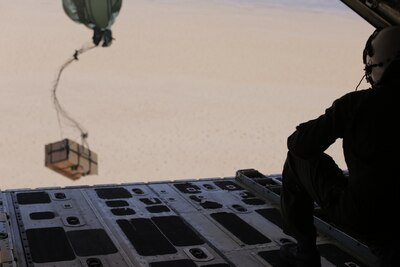By Marine Corps Cpl. Kyle McNan 1st Marine Logistics Group
CAMP PENDLETON, Calif., April 13, 2018 — When people need
medical care, time is always a factor. Service members can find themselves
operating in austere environments such as disaster relief areas and forward
operating bases, where transporting medical supplies can be a complex
undertaking.
Transporting supplies on the ground may not be an option, so
the Marines and sailors of the 1st Marine Logistics Group are working with
Marine Aerial Refueler Transport Squadron 152 to drop units of blood by air to
those operating in such inflexible areas.
“Currently, if you want to deliver blood, you have to put in
a request at the Joint Blood Program, who will fly it to a location outside the
intended area and it will then have to be transported via ground to the
surgical unit that needs it,” said Navy Lt. Joshua Knapp, the deputy health
service support officer for the 1st MLG’s Heath Service Support Element. “What
we are hoping to do is to develop the procedures so that we can actually fly
the blood to the surgical unit and drop it by air to the intended area.”
The units of blood were dropped from 500 feet by the KC-130J
Super Hercules, but the personnel involved did not know if the reinforced
packaging would protect the units. At 500 feet, the altitude did not have an
effect on the blood; however, the units had to maintain a temperature of 32 to
50 degrees Fahrenheit. With current packaging materials, units of blood are
able to maintain temperatures for 48 hours.
Many Moving Parts
Many different moving parts need to fall into place for this
concept to become a reality. First was getting the blood from Naval Medical
Center San Diego in California to Marine Corps Air Station Yuma in Arizona.
This was completed in an expedient manner to ensure the integrity and viability
of blood units were not compromised, and that they were subject to testing
shortly after being airdropped.
At MCAS Yuma, Marines with 1st, 2nd and 3rd MLG packed and
prepped the blood to be dropped out of a KC-130J Super Hercules. Marines from
the three logistics groups were involved to ensure training was shared across
the units.
Five packaging variations were used for the air delivery.
Each used materials from the authorized medical and dental allowance list and a
special insulated “Collins box” to include various parachute configurations.
Once the blood landed in the intended area, Navy corpsmen
with 1st MLG Health Service Support Element inspected the cases and blood bags
to make sure they were still viable. They found no evidence of damage to the
blood bags, and the performance of each packaging variation was recorded to
document and share the details of how to successfully accomplish this air
delivery technique.
Further Testing
The blood still needed to be transported back to Naval
Medical Center San Diego to test if hemolysis occurred -- the rupturing or
destruction of red blood cells. This can occur on impact, officials explained,
so it must be tested.
Though Naval Medical Center San Diego did find hemolysis
occurred in the units of blood being used in the exercise, it may have been due
to the age of the blood, which was 20 days past expiration, officials said.
Expired blood is used in the training to ensure viable blood is available for
those in need, they explained. The medical center staff is doing more tests to
determine whether the hemolysis occurred due to the blood samples being
expired.
The airdrop delivery was a successful training event for all
units involved. They will refine the training to make it a viable option for
the Marine Corps’ logistical requirements.
“The biggest thing that came from training is education to
the Marine Corps as a whole,” said Marine Corps Gunnery Sgt. Jacob Reichert,
the air delivery operations planner for the 1st MLG. “I want Marines to hear
about this and say, ‘Wow, they airdropped blood; I wonder what else we can
drop?’ We want to get this training to start a huge progression in the realm of
air delivery.”









No comments:
Post a Comment